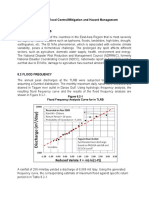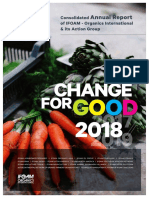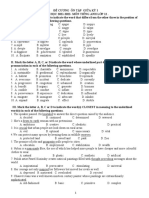Great Britain: 1. Geography and Geology
Great Britain: 1. Geography and Geology
Uploaded by
Svetlana ĐurkinjakCopyright:
Available Formats
Great Britain: 1. Geography and Geology
Great Britain: 1. Geography and Geology
Uploaded by
Svetlana ĐurkinjakOriginal Title
Copyright
Available Formats
Share this document
Did you find this document useful?
Is this content inappropriate?
Copyright:
Available Formats
Great Britain: 1. Geography and Geology
Great Britain: 1. Geography and Geology
Uploaded by
Svetlana ĐurkinjakCopyright:
Available Formats
GREAT BRITAIN
1.
GEOGRAPHY AND GEOLOGY
The United Kingdom of Great Britain comprises England, Scotland, Wales and Northern Ireland. It lies on the western edge of Europe and is surrounded by sea. No part of the country is more than 120km from tidal waters. The total area of the United Kingdom is 24.1 miffion ha. Great Britain can be divided roughly into two main areas - lowland Britain and highland Britain. In the former, in the midlands, southern and eastern England lies the new and softer rocks. The hilfier areas, in Scotland, most of Wales, the broad central uplands known as the Pennines, and the Lake District consist mainly of outcrops of very old rocks. Lowland Britain and most of Northern Ireland is under 300m above sea level. The younger rocks in this area break down more easily into soil; and so the greater part of lowland Britain comprises cultivated and settled areas, with varying textured soils from clay to sandy loam silt and peat. The soils on the hills are poor and thin, supporting coarse grasses, bracken, heather or trees. 2. CLIMATE AND RAINFALL
The climate of Great Britain is temperate and equitable. The prevailing winds are south- westerly and the climate is largely determined by that of the eastern Atlantic, although during the winter months easterly winds may bring a cold, dry, continental type of weather. The average range of temperature between winter and summer varies from 7' to 12'C, being highest inland in the eastern part of England. During a normal summer the temperature occasionally rises above 27'C; winter temperatures below -7'C are rare. Sunshine decreases from north to south. The average summer (April -
September) potential evapotranspiration ranges from about 230mm in the Scottish highlands to 500mm in East Anglia. The average annual rainfall over Great Britain is about 1,080 mm, ranging from over 4,000 mm in a few points in the hills of Wales, Northern Ireland and Scotland to 500 mm in parts of East Anglia. 3. POPULATION AND LAND USE
The population of Great Britain is about 56 million, giving an average population density of about 230 inhabitants/km2 with over 80% of the people living in towns. For many centuries most of the land in Britain lay in estates ranging in size from a few hundred hectares upwards, comprising farms of varying sizes let to tenants, Due to social changes and heavy estate duties, farms were sold and many were bought by the tenants. About half the farms in Great Britain today are owner occupied. The trend is towards larger units, particularly for arable farming. Of the total area of Great Britain of 24 million ha, about 7 million ha is arable land, I I million ha permanent grassland, 2 million ha is forested land and the rest, 4 million ha, is built on or wasteland. 4. WATER RESOURCES AND IRRIGATION
River water quality has improved over the last few decades as a result of improvements to effluent quality, particularly from sewage treatment works run by the private water companies. The quality of most rivers is now adequate for use for irrigation and attention is now being given to the control of diffuse sources of pollution, particularly from the use of pesticides and fertilisers on fields. Control of such pollutants is essential to ensure that groundwater resources are not polluted. All irrigation is carried out on an individual farm basis; there are no area or district schemes organised by public authorities. Some 90% of outside irrigation is spray. Trickle systems are used to a greater extent under glass and are becoming more popular for certain outside fruit crops where there is little cultivation and the pipes can remain in place for some years. The quantity of water licensed for abstraction in England and Wales for spray irrigation in 1995 was 289 million m3 (approximately 45% direct from surface, 40% from groundwater and 15% from surface water via reservoirs). In addition to this some 3% of the total demand for irrigation was taken from the public niains. Spray irrigation in England and Wales is concentrated in East Anglia, parts of the Trent Valley in the Mdlands and the Somerset levels and Wye Valleys. The area of crops irrigated in Scotland and Northern Ireland is very small and not included in the statistics. Across England and Wales in an average year only 2% of the total water abstracted is for spray irrigation and agriculture, compared to 51 % for public supply. However, in East Anglia where spray irrigation is concentrated the proportion is higher and on a warm summer day the amount taken for spray irrigation can exceed that taken directly from rivers and boreholes for public water supply. Demand for irrigation is forecast to increase substantially, particularly if climate change leads to warmer and drier summers. Much of the demand is driven by supermarkets seeking good quality vegetables and fruit. Reliable irrigation will improve the appearance and yield of crops and reduce the need for chemicals. Vegetable production is now an international business with British farmers competing with European and other countries without the benefit of subsidies and supports provided to cereal producers.
5.
INSTITUTIONAL ARRANGEMENTS
England and Wales The Environment Agency was set up by the British Government in 1997 to "protect and improve the environment for current and future generations". Amongst other responsibilities it is the licensing authority for water abstraction and has powers to protect people and property in low lying areas from flooding. The Agency has a statutory duty to secure the proper use of water resources, which includes; assessing the need for new developments and licences; ensuring that the most appropriate schemes are licensed, taking into account the environmental impact of new developments and the impact on existing users.
The Agency owns and operates a few raw water transfer and environmental support shemes. The financing, promotion and development of new schemes will normally be the concern of the main beneficiaries. The initiative for developing schemes rests with the water companies or other private sector investors. The Government and Environment Agency do not give grants for irrigation schemes. Farmers who wish to irrigate using spray equipment must have a licence from the Environment Agency. At present, trickle irrigation is not licensable, although the Government plans to introduce legislation to bring it under control. In some areas the Agency is not issuing any further summer surface water or groundwater abstraction licences because the limited resources are already committed to other users and/or the ecological requirements of streams and wetlands. In these areas expansion of irrigation can only be by abstracting winter water flows for storage in a reservoir for use in the irrigation season. Many of the most productive agricultural areas He in flood plains. Major drainage systems, often managed by Internal Drainage Boards, support local field drainage. The Environment Agency is responsible for the "main" rivers and sea defences, and work with financial support from the Ministry of Agriculture, Fisheries and Food and local authorities to maintain defence standards. In recent years there has been greater emphasis on protecting urban areas from flooding and protection of agricultural land is a lower priority. The Agency's Shoreline Management Plans are an example of the strategic approach to sea defences it is taking. It is working with the natural geomorphological processes, including where appropriate adopting 'managed retreat' options. 6. A VISION FOR THE 21st CENTURY
The vision statement: "the future is a world of well-fed people in a healthy environment containing viable and stable ecosystems" has been proposed as the basis of the vision for water for food and rural development in the 21' Century. This section suggests principles to support that vision and a minor change of wording. The concept of stable ecosystems implies that nature can be protected from natural as wen as man made forces. Scientists now consider it is unlikely that the climate win stay as it is. The world is now about 0.6'C warmer than it was a hundred years ago and the three warmest years globally have all occurred in the last decade. Stable ecosystems, in the sense that a particular site's characteristics do not evolve, is probably not feasible, and 'diverse'ecosystems would be a better phrase.
The following principles support a vision "a future is a world of well-fed people in a healthy environment containing viable and diverse ecosystems". Sustainable Development : ensuring no long term systematic deterioration in the water environment due to water resource development and water use; considering the full fife cost and environmental consequences of actions. Precautionary principle - where significant environmental damage may occur, but knowledge on the matter is incomplete, decisions made and measures implemented should err on the side of caution. Demand management - managing water use by economic incentives and other measures to make more efficient use of water, control waste and consumption, eg through leakage reduction and metering, irrigation scheduling and trickle irrigation. Twin Track Approach - making better use of available resources whilst planning to develop new resources as and when required, having considered the economic, social and environmental impacts. Integrated river basin management - achieving the 'right' quality and quantity of water in the 'right' place at the 'right' time. For example the Environment Agency's Local Environment Agency Plans (LEAPS) are based on river basins and cover 0 the functions of the Agency including water quality, waste regulation, flood defence, large industrial processes and water resources. They provide an open consultative approach to catchment management including ground and surface water protection. Environmentally sound market orientated agriculture - encouraging and supporting an efficient and competitive industry. This is Rely to include reform of the CAP and replacement of production subsidies with subsidies to support more nature-friendly farming practices. Ensure envirommental protection - valuing, restoring and protecting the natural ecology and rural landscape. This will require ensuring adequate water supplies, and is likely to require action at some sites damaged by licensed abstractions. Encourage Research and Development - encourage research and development and develop the exchange of best practices across all aspects of water for food and rural development, for example more efficient irrigation techniques and drought tolerant crops. Encourage stakeholder and public participation - stakeholder and public participation enables wider awareness and consideration of issues and improved decision making. 7. CONCLUSIONS
The vision statement: "the future is a world of well-fed people in a healthy environment containing viable and diverse ecosystems" is attainable. It will require governments, institutions and individuals to anticipate changes, use opportunities and manage the various natural and man-made stresses and strains. The goal is sustainable development, with full support from stakeholders. The British section of ICID will press for a holistic management approach and will support and encourage those adopting it.
You might also like
- Water Pollution in The Republic of Trinidad and TobagoDocument14 pagesWater Pollution in The Republic of Trinidad and Tobagowesleyf193% (14)
- The Bacolod City Tourism OfficeDocument24 pagesThe Bacolod City Tourism OfficeSchool of Hospitality and Tourism Management100% (1)
- Naga City Comprehensive Development PlanDocument144 pagesNaga City Comprehensive Development PlanJenny Rose Olfindo78% (9)
- State of The Environment Water Resources ReportDocument11 pagesState of The Environment Water Resources ReportShahzaib MalikNo ratings yet
- Template 1Document9 pagesTemplate 1Frank ChikaniNo ratings yet
- CitizenshipDocument8 pagesCitizenshipPriyansh GargNo ratings yet
- Topic 10 - The Environment and UsDocument37 pagesTopic 10 - The Environment and UsSegar Raja ManickamNo ratings yet
- Water ResourcesDocument11 pagesWater ResourcesGerrold RamosNo ratings yet
- Assignment: Deteriorating Natural Resources - A Business ChallengeDocument5 pagesAssignment: Deteriorating Natural Resources - A Business Challengeaniketg7No ratings yet
- Benefits of and Concerns About DamsDocument10 pagesBenefits of and Concerns About Damsمحمد فكريNo ratings yet
- State Water Recycling Strategy: An Overview June 2008Document10 pagesState Water Recycling Strategy: An Overview June 2008chitransh2002No ratings yet
- Water ConservationDocument6 pagesWater ConservationShubam SharmaNo ratings yet
- Landscape SustianabilityDocument40 pagesLandscape Sustianabilityamna dheliehNo ratings yet
- Different Sources of Water: DescriptionDocument4 pagesDifferent Sources of Water: DescriptionRichard Yves UbongenNo ratings yet
- Conferences: Defining Water Management For The 1980sDocument3 pagesConferences: Defining Water Management For The 1980sManticora VenerabilisNo ratings yet
- Day 2 - Geography Mains Q& A With TitbitsDocument5 pagesDay 2 - Geography Mains Q& A With TitbitsBabji ThothadiNo ratings yet
- Hydroelectric DamDocument5 pagesHydroelectric Dammuhammad israrNo ratings yet
- Why Do We Need DamsDocument4 pagesWhy Do We Need Damspashish77No ratings yet
- Environmental Changes Analysis: North South UniversityDocument5 pagesEnvironmental Changes Analysis: North South UniversityRomi SikderNo ratings yet
- ES UnitDocument38 pagesES UnitMOHD FAHEEMNo ratings yet
- Multi Agency Policy Brief Cop 15Document6 pagesMulti Agency Policy Brief Cop 1511426919No ratings yet
- Relevant Info For HIDocument2 pagesRelevant Info For HIaidenNo ratings yet
- V HungaryDocument9 pagesV HungaryMaria StoicaNo ratings yet
- Taster Document To ImproveDocument6 pagesTaster Document To ImproveBahria notyNo ratings yet
- Water As A ResourceDocument15 pagesWater As A ResourceAvrilNo ratings yet
- Discussion BoardDocument3 pagesDiscussion BoardayselguseinovhaNo ratings yet
- Water Resource and EvironmentDocument10 pagesWater Resource and EvironmentmismahikaNo ratings yet
- 6 Marine Resources, Blue EconomyDocument22 pages6 Marine Resources, Blue Economysakibhasandu3846No ratings yet
- DubeyDocument19 pagesDubeyRajeev TiwariNo ratings yet
- 21BCM053 Tutorial-2 EVSDocument3 pages21BCM053 Tutorial-2 EVSRonit BhattacharyaNo ratings yet
- Water Management FeaturesDocument5 pagesWater Management FeaturesSaketh VuppalapatiNo ratings yet
- Pressures On Water Supply 3.1 Climate ChangeDocument6 pagesPressures On Water Supply 3.1 Climate ChangeAshish Mani LamichhaneNo ratings yet
- Interview Guide-1Document17 pagesInterview Guide-1Anonymous hgpfWOOJ0No ratings yet
- Water Shortage New TemplateDocument10 pagesWater Shortage New TemplateH A G ERNo ratings yet
- Position Paper For Climate ChangeDocument4 pagesPosition Paper For Climate ChangeArnav SinghalNo ratings yet
- Research Report, Umurzoqova ZebinisoDocument26 pagesResearch Report, Umurzoqova ZebinisoZebiniso UmurzoqovaNo ratings yet
- En 8491 Water Supply EngineeringDocument36 pagesEn 8491 Water Supply EngineeringsanthiamuthaNo ratings yet
- Environmental Performance IndexDocument7 pagesEnvironmental Performance IndexskinnyleopardNo ratings yet
- EnvtstabilityDocument4 pagesEnvtstabilitySamuel MuhamiNo ratings yet
- Water ResourcesDocument13 pagesWater ResourcesNitish KumarNo ratings yet
- Depletion of WetlandsDocument6 pagesDepletion of WetlandsRuchika PanjwaniNo ratings yet
- Objectives of Soil and Water ConservationDocument15 pagesObjectives of Soil and Water ConservationMuhammad Usman AslamNo ratings yet
- CHAPTER 8 Flood Control/Mitigation and Hazard ManagementDocument11 pagesCHAPTER 8 Flood Control/Mitigation and Hazard ManagementCeline CervantesNo ratings yet
- The Global Water CrisisDocument3 pagesThe Global Water Crisiscoxam85845No ratings yet
- EEA SIGNALS 2018 Water Is Life CorrectedDocument80 pagesEEA SIGNALS 2018 Water Is Life CorrectedInternet GhoulNo ratings yet
- Document Sans TitreDocument4 pagesDocument Sans Titrefathimazunaira2012No ratings yet
- Term Paper On WetlandsDocument5 pagesTerm Paper On WetlandsBestOnlinePaperWritingServiceColoradoSprings100% (1)
- Catchment ManagementDocument4 pagesCatchment ManagementSachitha RajanNo ratings yet
- All Notes of ESDM Word-FileDocument104 pagesAll Notes of ESDM Word-FilerushikeshvharakNo ratings yet
- Coastal ReservoirDocument5 pagesCoastal Reservoirhram_phdNo ratings yet
- Reflective Essay # 2 - Remar I. Pabalay PDFDocument4 pagesReflective Essay # 2 - Remar I. Pabalay PDFRemar PabalayNo ratings yet
- Ce 2031 Water Resources EngineeringDocument30 pagesCe 2031 Water Resources EngineeringManikandan.R.KNo ratings yet
- Innovative Approaches and Successful Strategies For Sustainable Water Management in The CoDocument8 pagesInnovative Approaches and Successful Strategies For Sustainable Water Management in The CoColley MatheNo ratings yet
- Global Challenges For The Environment, Water Clean and Economic AdvantagesDocument5 pagesGlobal Challenges For The Environment, Water Clean and Economic AdvantagesseventhsensegroupNo ratings yet
- Hydro SphereDocument35 pagesHydro SphereKem IlaganNo ratings yet
- Water Framework DirectiveDocument4 pagesWater Framework DirectiveMilorad Zjalić100% (1)
- Water Crisis (Geography Project) WordDocument8 pagesWater Crisis (Geography Project) Wordsonuskrsms35No ratings yet
- A Shared Water Risk Assessment For A Vulnerable River Basin: River Rwizi in UgandaDocument12 pagesA Shared Water Risk Assessment For A Vulnerable River Basin: River Rwizi in Ugandakwikirizamonica73No ratings yet
- WatershedDocument20 pagesWatershedNEENU M GNo ratings yet
- Unit 3 - II - Water ResourcesDocument7 pagesUnit 3 - II - Water Resourcespalak662005No ratings yet
- Water Storgae FDocument4 pagesWater Storgae FANA MARIA BASNILLONo ratings yet
- The Global Water Crisis - Solutions for a Thirsty PlanetFrom EverandThe Global Water Crisis - Solutions for a Thirsty PlanetNo ratings yet
- Talent Management ReportDocument42 pagesTalent Management ReportVaibhav Agarwal100% (2)
- Study Guide For MUN SchoolDocument23 pagesStudy Guide For MUN SchoolRye SANo ratings yet
- Secondary RefDocument15 pagesSecondary Refvworldpeace yanibNo ratings yet
- GE-113 M6 AnswerDocument6 pagesGE-113 M6 AnswerJovelyn SanchezNo ratings yet
- LD02 Converted CompressedDocument47 pagesLD02 Converted CompressedShan AtrayNo ratings yet
- Stage 3 - Developed Design ChecklistDocument16 pagesStage 3 - Developed Design ChecklistVirah Sammy ChandraNo ratings yet
- Full-Time MBA Sdabocconi 2023 2024Document36 pagesFull-Time MBA Sdabocconi 2023 2024mbogo markNo ratings yet
- Importance of Interstate Regional Planning in India: June 2014Document5 pagesImportance of Interstate Regional Planning in India: June 2014Samrat DasNo ratings yet
- Financial Practices in Hero Future EnergiesDocument68 pagesFinancial Practices in Hero Future EnergiesRoopam ChandelNo ratings yet
- Patagonia: Corporate ResponsibilityDocument5 pagesPatagonia: Corporate ResponsibilityFátima PonceNo ratings yet
- Te Kupenga o Ngati Kuta Me Patukeha Ki Te Rawhiti Hapu Moana Management PlanDocument31 pagesTe Kupenga o Ngati Kuta Me Patukeha Ki Te Rawhiti Hapu Moana Management PlanlellobotNo ratings yet
- Annualreport 2018Document22 pagesAnnualreport 2018AdrianBostanNo ratings yet
- A Framework To Harness Effective Partnerships ForDocument16 pagesA Framework To Harness Effective Partnerships ForSylvain N'CHONo ratings yet
- Sustainability in Building Design and ConstructionDocument3 pagesSustainability in Building Design and ConstructionMark Alvin L. AcordaNo ratings yet
- ĐỀ CƯƠNG GIỮA KÌ I - G12 T.AnhDocument16 pagesĐỀ CƯƠNG GIỮA KÌ I - G12 T.Anh44o4c4ng444tNo ratings yet
- SD 5066A 1 1 BREEAM Europe Commercial 2009Document346 pagesSD 5066A 1 1 BREEAM Europe Commercial 2009tranenvironnementNo ratings yet
- Corporate Social Responsibility: The ConceptDocument23 pagesCorporate Social Responsibility: The ConceptkirmaijadNo ratings yet
- Documentmass 3658Document52 pagesDocumentmass 3658dominique.neihart714No ratings yet
- Touching Hearts Renewing Mind Transforming LivesDocument2 pagesTouching Hearts Renewing Mind Transforming LivesJoneric RamosNo ratings yet
- Env Degrad NSRAPEM2015Document5 pagesEnv Degrad NSRAPEM2015ShashankNo ratings yet
- The Reality of Poverty, Mbarara-UgandaDocument47 pagesThe Reality of Poverty, Mbarara-UgandaThe Bartlett Development Planning Unit - UCL100% (1)
- History of Sustainable Development Condensed 26 - 50Document25 pagesHistory of Sustainable Development Condensed 26 - 50firesign58100% (1)
- CS Index AlbaniaDocument54 pagesCS Index AlbaniaamaliaNo ratings yet
- Final Bedford - 1500 Words - July 11Document10 pagesFinal Bedford - 1500 Words - July 11KAZI ZINIANo ratings yet
- Environmental ScienceDocument5 pagesEnvironmental Sciencearijit_ghosh_18No ratings yet
- Medium Pressure RangeDocument122 pagesMedium Pressure Rangexuanphuong2710No ratings yet
- The Construction Sector of Indonesia: 18th Asia Construct ConferenceDocument17 pagesThe Construction Sector of Indonesia: 18th Asia Construct ConferenceTio IskandarNo ratings yet
- Notes On CH-1 ResourcesDocument3 pagesNotes On CH-1 ResourcesHemant SinghNo ratings yet

























































































